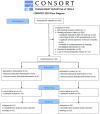On-Site Physiotherapy in Emergency Department Patients Presenting with Nonspecific Low Back Pain: A Randomized Controlled Trial
- PMID: 38892860
- PMCID: PMC11173222
- DOI: 10.3390/jcm13113149
On-Site Physiotherapy in Emergency Department Patients Presenting with Nonspecific Low Back Pain: A Randomized Controlled Trial
Abstract
Background: There is a high incidence of nonspecific Low Back Pain (LBP) in patients visiting Emergency Departments (EDs), but there is a lack of knowledge regarding emergency physiotherapy for LBP. The effect of on-site physiotherapy in these patients was therefore never demonstrated. We assessed short-term outcomes, feasibility and patient satisfaction with physiotherapy in ED patients presenting with nonspecific LBP. Methods: A block-randomized, controlled, open-label trial with a follow-up of 42 days. Patients aged 18 years or older presenting to an ED with nonspecific LBP were prospectively enrolled. Both groups received the same booklet with written information on LBP management and exercises. Patients in the intervention group were given additional instructions by a certified physiotherapist. Results: We included 86 patients in the primary analysis. The median age was 40, and 40.7% were female. At day 7, the median Oswestry Disability Index (ODI) was 2 points lower in the intervention group compared to the control group, which was not statistically significant. There was no between-group difference in pain at day 7. Patients who received physiotherapy felt significantly more confident with the exercises they were taught (p = 0.004, effect size = 0.3 [95% CI 0.1 to 0.5]). Conclusions: On-site physiotherapy in ED patients presenting with nonspecific low back pain is associated with higher patient satisfaction, compared to standard of care. The effect of physiotherapy was small, with only minimal improvement in disability, but without a reduction in pain. Despite the very small effect size, physiotherapeutic interventions should be investigated in larger cohorts with an extended intervention including patient education, exercises, and other physiotherapeutic modalities.
Keywords: disability; emergency department; feasibility; nonspecific low back pain; physiotherapy; randomized controlled trial; satisfaction.
Conflict of interest statement
The authors declare no conflicts of interest.
Figures




Similar articles
-
The 3-Month Effectiveness of a Stratified Blended Physiotherapy Intervention in Patients With Nonspecific Low Back Pain: Cluster Randomized Controlled Trial.J Med Internet Res. 2022 Feb 25;24(2):e31675. doi: 10.2196/31675. J Med Internet Res. 2022. PMID: 35212635 Free PMC article. Clinical Trial.
-
Effectiveness and Cost-Effectiveness of a Stratified Blended Physiotherapy Intervention Compared With Face-to-Face Physiotherapy in Patients With Nonspecific Low Back Pain: Cluster Randomized Controlled Trial.J Med Internet Res. 2023 Nov 24;25:e43034. doi: 10.2196/43034. J Med Internet Res. 2023. PMID: 37999947 Free PMC article. Clinical Trial.
-
Is immediate imaging important in managing low back pain?J Athl Train. 2011 Jan-Feb;46(1):99-102. doi: 10.4085/1062-6050-46.1.99. J Athl Train. 2011. PMID: 21214357 Free PMC article.
-
Unveiling the Efficacy of Physiotherapy Strategies in Alleviating Low Back Pain: A Comprehensive Review of Interventions and Outcomes.Cureus. 2024 Mar 12;16(3):e56013. doi: 10.7759/cureus.56013. eCollection 2024 Mar. Cureus. 2024. PMID: 38606230 Free PMC article. Review.
-
Therapeutic ultrasound for chronic low back pain.Cochrane Database Syst Rev. 2020 Jul 5;7(7):CD009169. doi: 10.1002/14651858.CD009169.pub3. Cochrane Database Syst Rev. 2020. PMID: 32623724 Free PMC article.
References
-
- GBD 2016 Disease and Injury Incidence and Prevalence Collaborators. Carapetis J.R., Dadi A.F. Global, regional, and national incidence, prevalence, and years lived with disability for 328 diseases and injuries for 195 countries, 1990–2016: A systematic analysis for the Global Burden of Disease Study 2016. Lancet. 2017;390:1211–1259. doi: 10.1016/S0140-6736(17)32154-2. - DOI - PMC - PubMed
LinkOut - more resources
Full Text Sources
Miscellaneous

